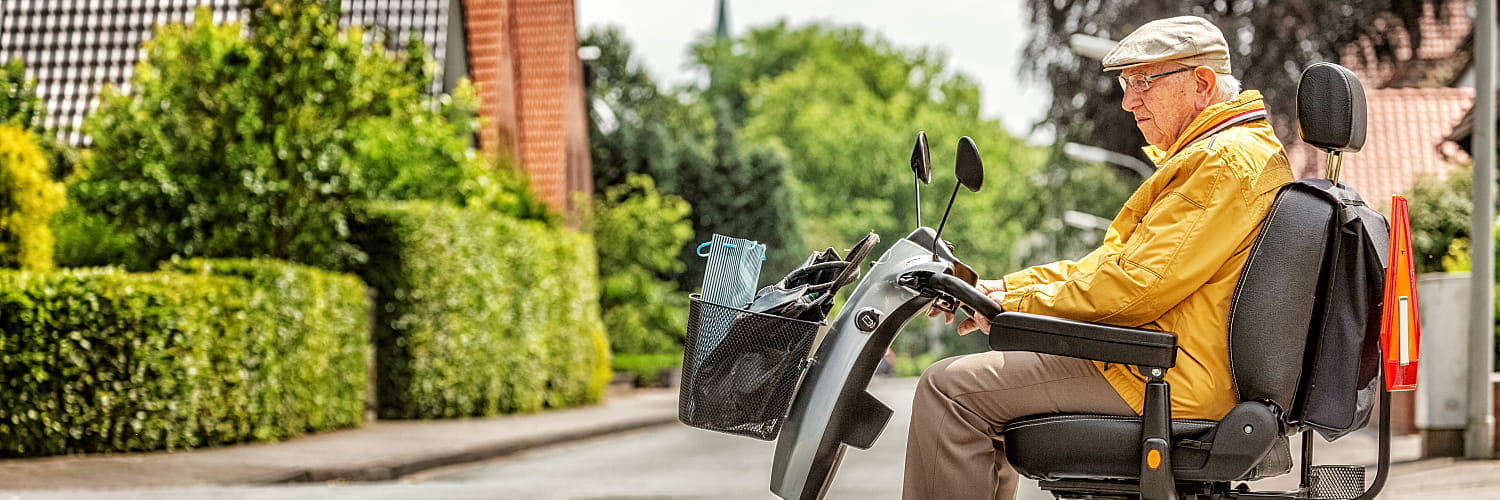Many retirees hope to age in place in the comfort of home. This often involves implementing structural modifications such as wheelchair ramps, grab rails and widened doorways that make it possible to remain mobile. However, house modifications are not the only way to ensure your environment stays accessible as you get older.
Many different types of mobility aids are available to help you get around. Whether you'd like help steadying yourself around the house or you're looking to travel comfortably outside the home, you can find a mobility aid that helps you maintain your freedom of movement.
Canes
You'll find a wide selection of cane styles, colors and types at retail locations such as your local drugstore and online. Canes are available in three different types:
- Standard canes have a curved or horizontal grip that may be cushioned at the top and have a rubberized tip that contacts the ground. Canes offer stability for those with limited mobility issues.
- Quad canes have four points of contact with the floor to offer added balance.
- Folding canes are portable and can be taken apart for storage or travel.
Cost: $20 to $50. Covered by Medicare Plan B if medically necessary.
Walkers
Walkers typically have between two and four points of contact, potentially with wheels, offering a place for you to stand behind the frame to grip the walker. Some walkers are portable and fold for storage or transport in the car.
Cost: $30 to $100. Covered by Medicare Plan B if medically necessary.
Rollator Walkers
Rollators are walkers with wheels, a seat, a handlebar and often a brake handle and storage basket. Rollators may have three or four wheels as well as a seat to rest on if you get tired in line or while out shopping. Some go all-terrain for outdoor activities. Because you must use your own strength to move the rollator, it's important that you have good balance and enough strength to push the wheeled walker.
Cost: $100 to several hundred dollars. Covered by Medicare Plan B if medically necessary.
Power Wheelchairs
If it's difficult to manually roll a wheelchair, an electric wheelchair powered by a battery can help you remain mobile both inside and outside the home. Users can control accelerating, braking and steering with a joystick or other controls on the handlebar.
Cost: $1,000 to $4,000, although some models are more expensive. Covered by Medicare Plan B if medically necessary.
Mobility Scooters
Mobility scooters have a rechargeable battery, come with either three or four wheels and are available in various sizes and styles. Some mobility scooters are smaller and more lightweight than others and can easily be taken apart and folded for car transport. Smaller scooters may get only around eight miles before depleting the battery, but some larger scooters can go for up to 40 miles on a single battery charge.
Cost: $800 to $3,300. Covered by Medicare Plan B if medically necessary.
Medical Alert Devices
Many medical alert devices now have GPS and fall detection. If you fall while away from home, a representative with the medical alert company will be able to find your location and call on the device to check whether you need help. You can wear medical alert devices as a pendant, carry one in your pocket or wear it as a watch that connects to Bluetooth and your phone.
Cost: $20 to $50 a month and up. May be covered by some Medicare Advantage plans.
As you decide how you'd like the support of mobility aids, explore which options might fit your needs — and try them out before buying, if possible. Before long, you'll be on the go comfortably, whether just around the house or out and about.


 Deb Hipp
Deb Hipp










